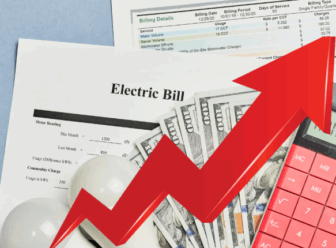The Governor’s Commission on Climate Change is meeting tomorrow, October 23. The current plan falls shockingly short of what scientists say is necessary to avoid the worst consequences of global warming. Governor Kaine’s plan would return Virginia to 2000 emissions levels by 2025. Scientists, in comparison, say we must cut emissions 25% below 1990 levels by 2020! This means that by 2020 Virginia should reduce emissions 35% below the 2000 level. The Commission on Climate Change has the ability to increase those targets.
Virginia Environmental Organizations’ Core Recommendations to the Governor’s Commission on Climate Change
Secretary L. Preston Bryant, Chair and Members of the Governor’s Commission on Climate Change
Dear Mr. Secretary and Commission members,
We recognize that developing climate change policy recommendations is an extremely complex endeavor. The variety of sources of carbon emissions, combined with the even greater number of control measures, the uncertain economics, and the competing stakeholders make this a most difficult charge.
To provide Commissioners with guidance from the Virginia environmental community in evaluating the recommendations that come before you, we, the listed environmental organizations, offer the following core recommendations for your consideration prior to your October 23 Commission meeting.After we have had an opportunity to review the four Work Group’s recommendations, we will offer more specific recommendations consistent with these core principles.
1) The need for science based standards for carbon emission reductions
The Governor’s Commission on Climate Change should recommend that Virginia adopt science- based carbon reduction emission goals of 80% by 2050 below 1990 levels with an interim goal of 25% by 2020. To ensure that the state is making progress toward these goals, the Commission should recommend that the state adopt annual emission targets and issue yearly progress reports on the success of measures to reduce emissions.
NARRATIVE: The more than 2000 climate scientists from around the world who comprise the United Nation’s Intergovernmental Panel on Climate Change (IPCC) have assessed the consequences of global warming and an increase in the average global temperature. From that assessment there is general consensus that in order to avoid the worst consequences of climate change, we should limit any rise in average global temperature to less than 2
degrees Celsius.From the 4th Assessment Report of the IPCC on “Impacts, Adaptation and Vulnerability,’ issued in April 2007, it is clear that Virginia will experience significant direct impacts as a result of climate change, perhaps the most serious being sea level rise. Increased frequency of severe weather events including flooding and hurricanes are also likely.
To avoid exceeding a temperature increase of 2 degrees Celsius, the Fourth Assessment Report of the IPCC indicates that we need to reduce carbon emissions by at least 80% by 2050 below 1990 levels. An interim reduction goal by industrialized nations of 25% to 40% by 2020 is needed to stabilize and begin reversing the concentration of carbon dioxide in the atmosphere.
2) Efficiency First
The Governor’s Commission on Climate Change should recommend that the State adopt such policies as are necessary to implement the high case scenario of the ACEEE report. These efficiency goals must be mandatory. Any utility incentives should be structured to reward investments in both efficiency and demand response, while ensuring that electricity consumers receive an equitable share of the substantial cost savings from these programs. Goals for increased efficiency in land use and transportation should be established using reductions in vehicle miles traveled (VMTs) as one of the measures of success.
NARRATIVE: Energy efficiency, demand side management and energy conservation provide Virginia with the most cost-effective means of reducing carbon emissions. The cheapest kilowatt is the one you don’t use. An average cost of $0.03 per kWh of energy saved makes efficiency far and away the most economical way of addressing the state’s energy needs. Properly structured efficiency programs can capture Virginia’s great untapped efficiency
potential, dramatically curtailing the state’s carbon footprint while saving billions of dollars in energy costs.In September, the American Council for an Energy Efficient Economy (ACEEE), issued its report: Energizing Virginia: Efficiency First The ACEEE report identifies the vast unexploited cost-effective efficiency resources available to the state. It outlines three policy-achievable scenarios with different levels of efficiency investments.
The “medium case policy scenario” would yield a savings of 28,000 GWh in 2025, or 19% of the state’s projected energy needs. This scenario would allow Virginia to “generate” 6,128 MW of power through efficiency-more than the output of 10 Wise County coal plants. The net cumulative savings to Virginia customers would total $15 billion by 2025, and the efficiency measures would produce 9,820 new jobs in the state.
Adopting the most aggressive suite (the high case scenario) of policies identified by the ACEEE would result in energy savings of 39,000 GWh in 2025, meeting 27% of Virginia’s annual electricity needs. The ACEEE also found that this suite of policies combined with “demand response can reduce peak demand by nearly 11,000 MW in 2025, or a 36% reduction in peak demand.”
Additionally, efficiency conscious land use and transportation decisions can reduce energy demands associated with development. Reductions in vehicle miles traveled is an effective measure of improved land use and transportation efficiency.
3) Renewable Energy Opportunities
The Governor’s Commission on Climate Change should recommend a mandatory renewable energy standard of 20% by 2020 combined with programs to educate the public, remove barriers to implementation, and encourage the development of the wind and solar industry in Virginia to complement or supplement recently extended Federal incentive for wind and solar development. Renewable sources produce energy without depleting natural resources or
systems, without creating hazardous emissions or waste and which have a demonstrated low carbon life-cycle. This would include such sources as solar, wind, tidal, small scale hydro, geothermal and sustainable bio-fuels. Nuclear power, waste-coal and municipal- solid waste should be excluded from any Renewable Energy Standard.NARRATIVE: Renewable sources can provide the state with clean energy, while protecting consumers from the escalating costs and price volatility of conventional fuels. The state’s modest investment in Virginia Coastal Energy Research Consortium (VCERC) only begins to suggest the opportunities to generate electricity and bio-fuels from renewable resources within the state.
VCERC has determined that offshore wind resources could conservatively supply 4 GW of electricity just off the coast of Virginia Beach. Developed as part of a system of wind farms along the Mid Atlantic Bight from NC to Massachusetts connected by an offshore smart grid, offshore wind could be a reliable, cost effective source of renewable electric power.
Wind energy is already competitive with coal-fueled electricity (even apart from the costs of greenhouse gas emissions and the many other negative externalities associated with coal) and is substantially cheaper than nuclear. The potential for responsibly sited land based wind farms in mountainous areas of the state, now economically dependent on coal mining,
provides an opportunity to generate electric power while creating more jobs than coal mining now provides.Solar PV powered electric generation in Virginia, while not currently as economical as wind or as solar t
hermal generation in the Southwest, is still an important potential source of electricity. Major investments in solar by North Carolina, New Jersey and Germany, demonstrate the viability of solar power. According to an assessment by Virginia Tech, there is a physical potential for distributed solar PV generation of “about 16-19 percent of
Virginia’s annual electrical demand with peak generating capacity of about 11,700 to 13,000 MW”. [A STUDY OF INCREASED USE OF RENEWABLE ENERGY RESOURCES IN VIRGINIA, Performed by The Virginia Center for Coal and Energy Research, p 19, Virginia Polytechnic Institute and State University, Nov. 11, 2005.]Building designs that incorporate passive solar heating in winter and shading from the sun in summer can significantly reduce the energy demands on HVAC systems.
4) Economic Opportunities associated with taking a leadership role in addressing climate change
The Governor’s Commission on Climate Change should recommend that Virginia take action to attract and support renewable energy and efficiency industries, including fostering Research &Development in Virginia universities to establish the infrastructure of scientific and technical
expertise.NARRATIVE: The state of Virginia was a major beneficiary of the economic growth of the information technology sector. Recognizing that the United States must eventually take aggressive action to reduce carbon emissions, the Commonwealth could be in an economically advantageous position if it is an earlier adopter of efficiency, demand response and renewable energy technologies. These clean energy technologies represent the wisest
investment Virginia can make in its energy future and the most cost-effective approach to reducing greenhouse gas emissions.The following organizations support these Core Recommendations to the Governor’s Climate Commission:
Appalachian Voices
Audubon Naturalist Society
Chesapeake Climate Action Network
Clean Water Action
Friends of Dyke Marsh
Friends of Stafford Creeks
Garden Club of Virginia
Goose Creek Association
Greater Washington Interfaith Power & Light
National Audubon Society
Natural Resources Defense Council
Sierra Club
Southern Appalachian Mountain Stewards
Virginia Conservation Network
Virginia Interfaith Power and Light
Virginia League of Conservation Voters
Wildlife Center of Virginia
Click here to see an account of the last commission meeting>>




